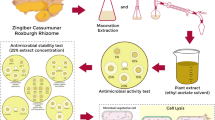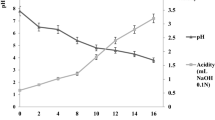Abstract
Kimchi fermentation is complex process which really depends on the composition of microfloa under the optimum ripening environment such as salt concentration, acidity, pH and temperature conditions. Most kinds of bacteria belonging to Lactobacillus group have been identified in kimchi, which continuously produce lactic acids after ripening and cause the change of kimchi tasty and physical texture. Green tea extract as a natural preservative was investigated on the antimicrobial activity and the change of pH, in terms of retardation of kimch fermentation. Minimal Inhibitory Concentration (MIC), paper disc assay, bacterial growth, and pH change were tested against four microorgasnisms, Leuconostoc mesenteroides, Lactobacillus sake, Lactobacillus plantarum, and Weissella koreensis. 2 mg/mL of green tea extract completely inhibited the growth of test organisms after 5–7 hours. Furthermore, it showed the maximized clear zone (24–34 mm) was observed at the 2mg/disc concentration. pH change resulted in a slow downward drift for fermentation period. Moreover, green tea extract showed long-term buffer effects for over 35 days (5 weeks) at 4°C.
Similar content being viewed by others

References
Lee, M. A. et al. Effects of kimchi ethanolic extracts on oxidative stability of refrigerated cooked pork. Meat. Sci. 89, 405–411 (2011).
Chung, H. K., Park, J. Y., Cho, Y. & Shin, M. J. Contribution of dietary patterns to blood heavy metal concentrations in Korean adults: Findings from the Fifth Korea National Health and Nutrition Examination Survey 2010. Food Chem. Toxicol. 62, 645–652 (2013).
Lee, J. S. et al. Analysis of kimchi microflora using denaturing gradient gel electrophoresis. Int. J. Food Microbiol. 102, 143–150 (2005).
Chang, H. W. et al. Analysis of yeast and archaeal population dynamics in kimchi using denaturing gradient gel electrophoresis. Int. J. Food Microbiol. 126, 159–166 (2008).
Ahmad Rather, I. et al. Isolation and characterization of a proteinaceous antifungal compound from Lactobacillus plantarum YML007 and its application as a food preservative. Lett. Appl. Microbiol. 57, 69–76 (2013).
Brul, S. & Coote, P. Preservative agents in foods. Mode of action and microbial resistance mechanisms. Int. J. Food Microbiol. 50, 1–17 (1999).
Szczepaniak, S. et al. The synergism of natural compounds in the pursuit of safe and healthier food. J. Ind. Microbiol. Biotechnol. 38, 215–220 (2011).
Arroyo Lopez, F. N., Duran Quintana, M. C. & Garrido Fernandez, A. Microbial evolution during storage of seasoned olives prepared with organic acids with potassium sorbate, sodium benzoate, and ozone used as preservatives. J. Food Prot. 69, 1354–1364 (2006).
Choi, M. H. & Park, Y. H. Selective control of lactobacilli in kimchi with nisin. Lett. Appl. Microbiol. 30, 173–177 (2000).
Park, J. M. et al. Effect of antioxidant activity in kimchi during a short-term and over-ripening fermentation period. J. Biosci. Bioeng. 112, 356–359 (2011).
Su, Y., Zhang, C., Wang, Y. & Li, P. Antibacterial property and mechanism of a novel Pu-erh tea nanofibrous membrane. Appl. Microbiol. Biotechnol. 93, 1663–1671 (2012).
Lee, W., Shin, T. S., Ko, S. & Oh, H. I. Control of dongchimi fermentation with chitosan deacetylated by alkali treatment to prevent over-ripening. J. Food Sci. 75, M308–316 (2010).
Kawaguchi, K., Matsumoto, T. & Kumazawa, Y. Effects of antioxidant polyphenols on TNF-alpha-related diseases. Curr. Top Med. Chem. 11, 1767–1779 (2011).
Author information
Authors and Affiliations
Corresponding authors
Additional information
These authors contributed equally to this work.
Rights and permissions
About this article
Cite this article
Ahn, JY., Min, J., Lee, SH. et al. Antimicrobial activities of green tea extract on the retardation of kimchi fermentation. Toxicol. Environ. Health Sci. 5, 197–200 (2013). https://doi.org/10.1007/s13530-013-0176-3
Received:
Revised:
Accepted:
Published:
Issue Date:
DOI: https://doi.org/10.1007/s13530-013-0176-3



